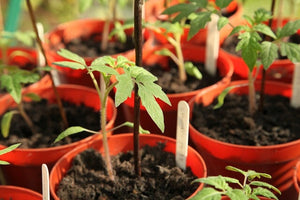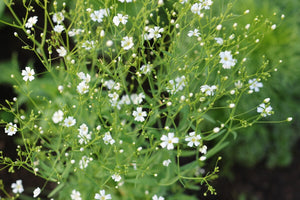Best Friend in the Garden and Edible Flower: How to Grow Nasturtium From Seed
NasturtiumNasturtiums are low-maintenance flowers on several of our gardening lists at Sow Right Seeds. Nasturtiums are edible, easy to grow from seed, and a great companion plant. Get to know nasturtium and start growing this friendly flower in your garden.

How to Grow Nasturtium From Seed
One of our easiest flowers to grow from seed, nasturtiums can be started indoors or directly sown outside after the last spring frost. For earlier spring blooms, start seeds indoors 2 to 4 weeks before the last spring frost date.

Tips for fail-proof nasturtium seed germination
Nasturtium seeds have a thick coat and will germinate quicker when soaked for 12 hours or by scarifying or nicking the seed.
Sowing Nasturtium Seeds Indoors:
Use biodegradable pots to avoid root damage and transplant shock.
Plant 2 to 3 nasturtium seeds per hole 1/2” deep in moist seed starting mix.
Use a humidity dome to retain moisture until seeds sprout.
Seeds will germinate in 7 to 14 days.
Place grow lights close to the seedlings.
Thin seedlings to the strongest plant after they have several sets of leaves and are 3” tall.
Once the danger of frost has passed, harden off seedlings before transplanting outdoors.

Sowing Nasturtium Seeds Outdoors:
Nasturtium is sensitive to transplanting, so direct sowing is recommended.
Plant nasturtium seeds 1 to 2 weeks after the last spring frost.
Soil temperature should be between 55º and 65ºF.
You can continue to succession sow nasturtium seeds for several weeks.
Plant seeds to a depth of 1/2” and 10 to 12” apart.
Keep the soil moist until the plants are well established.
Cover and protect young plants from frost. When fully grown, they can tolerate light frost but will die in freezing temperatures.
Thin nasturtium plants after the seedlings have several sets of leaves and are 3" tall.

How to Grow and Maintain Nasturtium Plants
Nasturtium is so low-maintenance you can almost plant and forget about them. They thrive in full sun and well-draining soil without a lot of nutrients.
Sun
Grow nasturtium in full sun. They can tolerate shade but won’t have as many blossoms. In extra-hot climates, nasturtiums will enjoy afternoon shade. Since they are an edible flower, one thing to note is the flavor becomes more intense when they are stressed by hot temperatures. High heat will also cause them to stop blooming.
Soil
Plant nasturtium in well-draining soil. Nasturtium does not need nutrient-rich soil and will bloom better in poor soil. Rich soil will result in lots of leaf growth but fewer blossoms.
Watering
Nasturtium needs consistent watering. They are drought tolerant but will not have as many blooms without sufficient water.
Fertilizing
Nasturtium grows well in poor soil and doesn’t need extra fertilizer. Only apply a balanced fertilizer if the soil is extremely poor.
Deadheading
Cut off faded flowers to encourage more blooms. Deadheading and trimming nasturtium plants will encourage new growth until the first fall frost.

Solutions for nasturtium pests and diseases
Nasturtiums are excellent companion plants because they attract aphids and cabbage worms.
While these beautiful flowers can be used as a trap crop to keep pests away from vegetable plants, you'll want to use natural methods to get rid of aphids and wash all parts of the plant before eating.
Nasturtium is not prone to diseases and will only get fungal diseases if watered too much and the leaves stay wet.
Harvesting Nasturtium
Nasturtium can be harvested and used in floral arrangements or as a beautiful and peppery garnish.
Nasturtium in Floral Arrangements
Cut nasturtium in the early morning for use in cut flower arrangements. Place in water, and the flowers will last about seven days.

Nasturtium as an edible plant
Nasturtium has a peppery taste, and the leaves, blossoms, and seed pods are all edible. You can harvest nasturtium leaves and flowers at any time. They add flavor and color to a variety of dishes.
If you are eating the seed pods, harvest them before they become mature and hard. The seeds can be pickled and used as a substitute for capers.
Wash harvested leaves and flowers before eating. Tasty, clean nasturtium plants are another reason to avoid fertilizers and pesticides.
Use sharp flower scissors to make clean cuts when harvesting or pruning nasturtium.

Nasturtium as a companion plant
Companion planting is a way to pair plants to repel pests or use them as a trap crop. Nasturtium can be used as a trap crop for aphids.
In a university study, nasturtium grown next to other crops resulted in fewer squash bugs and cabbage worms. Interplant your squash and cabbage with beautiful nasturtium flowers.
Nasturtium is also used as a companion plant to attract beneficial bugs like hoverflies and pollinators.

Heirloom Nasturtium Varieties to Grow
Alaska Nasturtium
This dwarf variety of nasturtium has green and white variegated leaves that look stunning in flower arrangements and as an edible garnish. This is a mounding or low-growing plant that grows well in containers. The cheerful yellow, orange, red, and pink flowers are edible and add a peppery zest to salads.
Tom Thumb Nasturtium
This heirloom nasturtium variety has bright red, orange, and yellow colors of heirloom nasturtium. Tom Thumb nasturtium grows 6 to 9” tall.

Nasturtium FAQs
Do hummingbirds like nasturtium?
The nectar in nasturtium blossoms is very sweet, and hummingbirds love it. The shape and color of nasturtium flowers are also attractive to hummingbirds. Read here for more flowers that attract hummingbirds.
Does nasturtium come back every year?
In gardening zones 9-11, nasturtium are perennials. When left to go to seed, nasturtium will self-seed. Otherwise, you will need to plant new seeds each year.
Why isn’t my nasturtium blooming?
Nasturtium needs full sun and warm temperatures to bloom. If your plants are in the shade, there will be few flowers. Also, rich soil will result in big plants and few blossoms.
It’s time to make nasturtium your new best friend in the garden. It’s so simple to grow from seed that you’ll be able to easily grow enough for eating, companion planting, and enjoying extra blooms indoors.
Happy Growing!
Popular Posts
-

How to Start Tomatoes from Seed – The FAQs Every Gardener Asks
-

Baby's Breath: How to Grow a Timeless Classic







Leave a comment